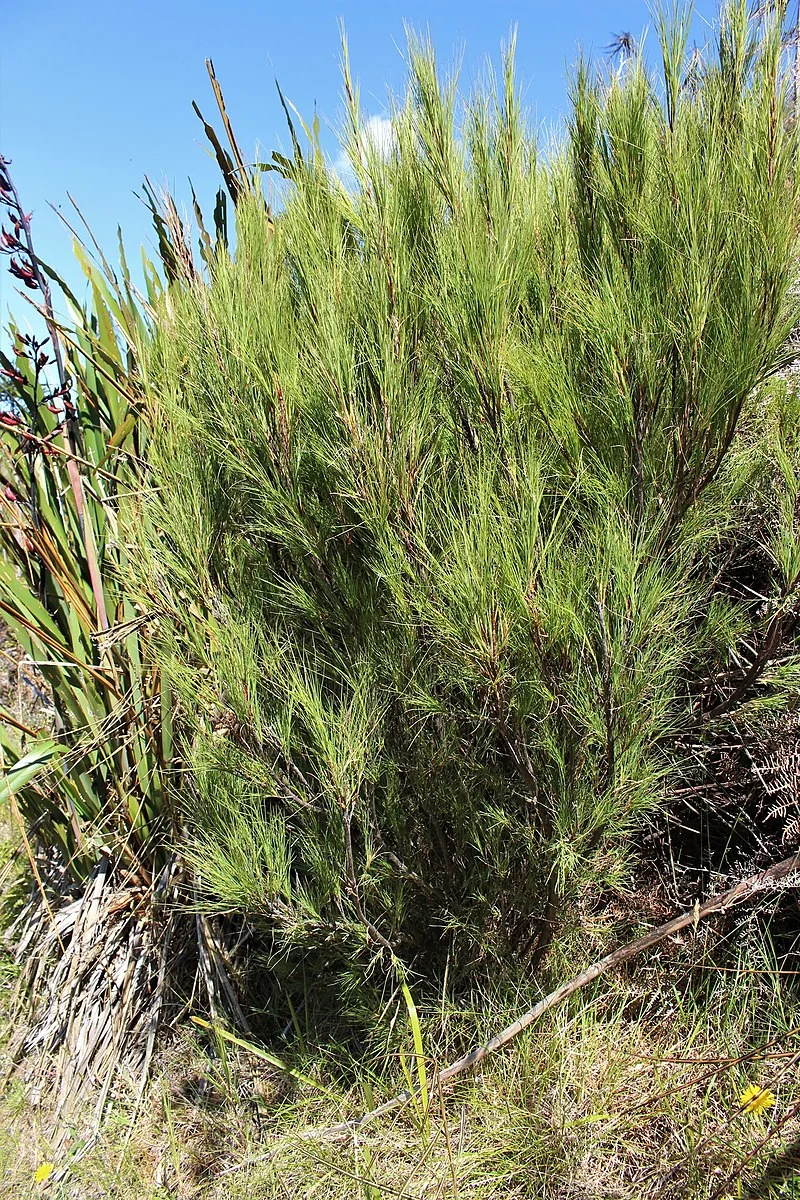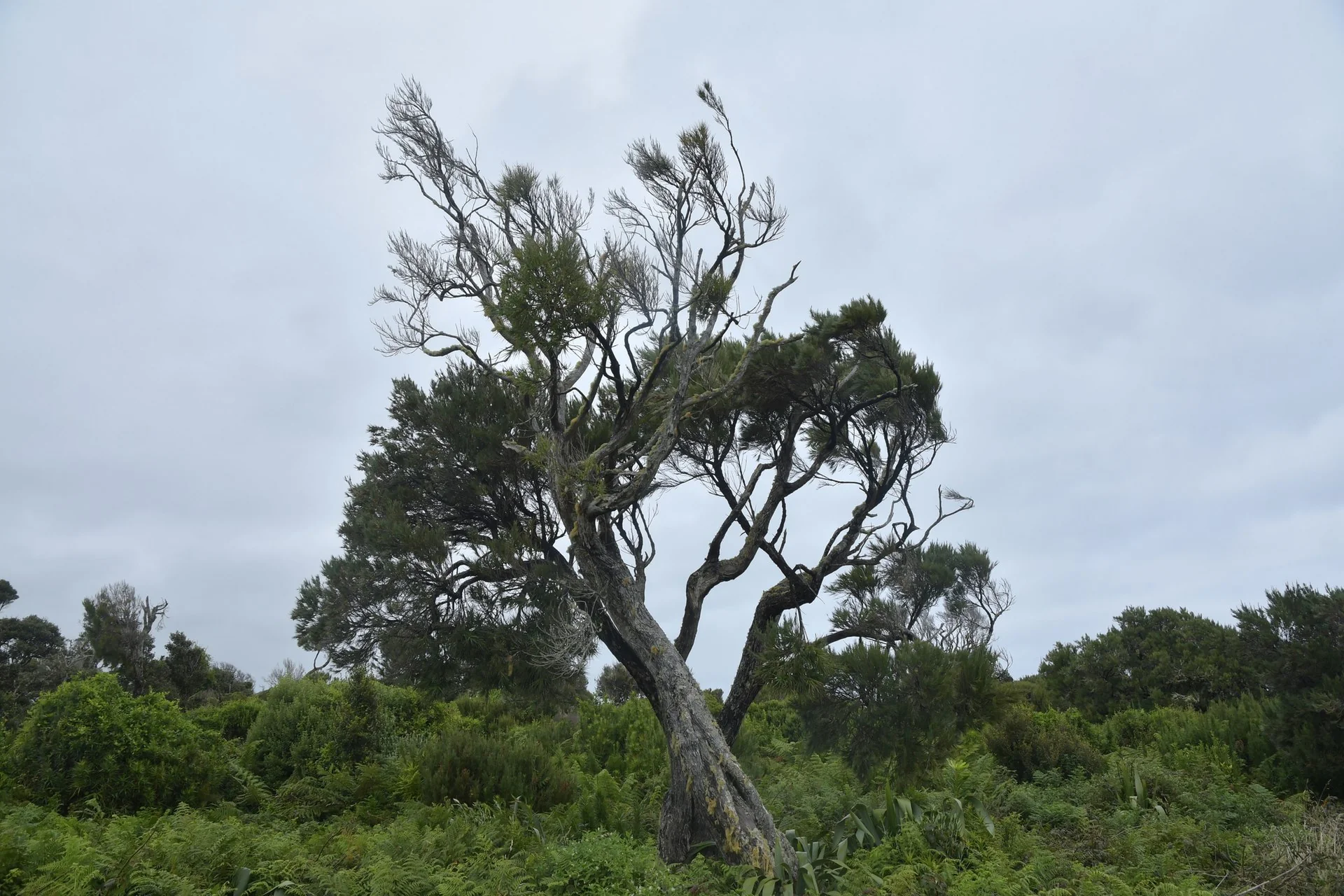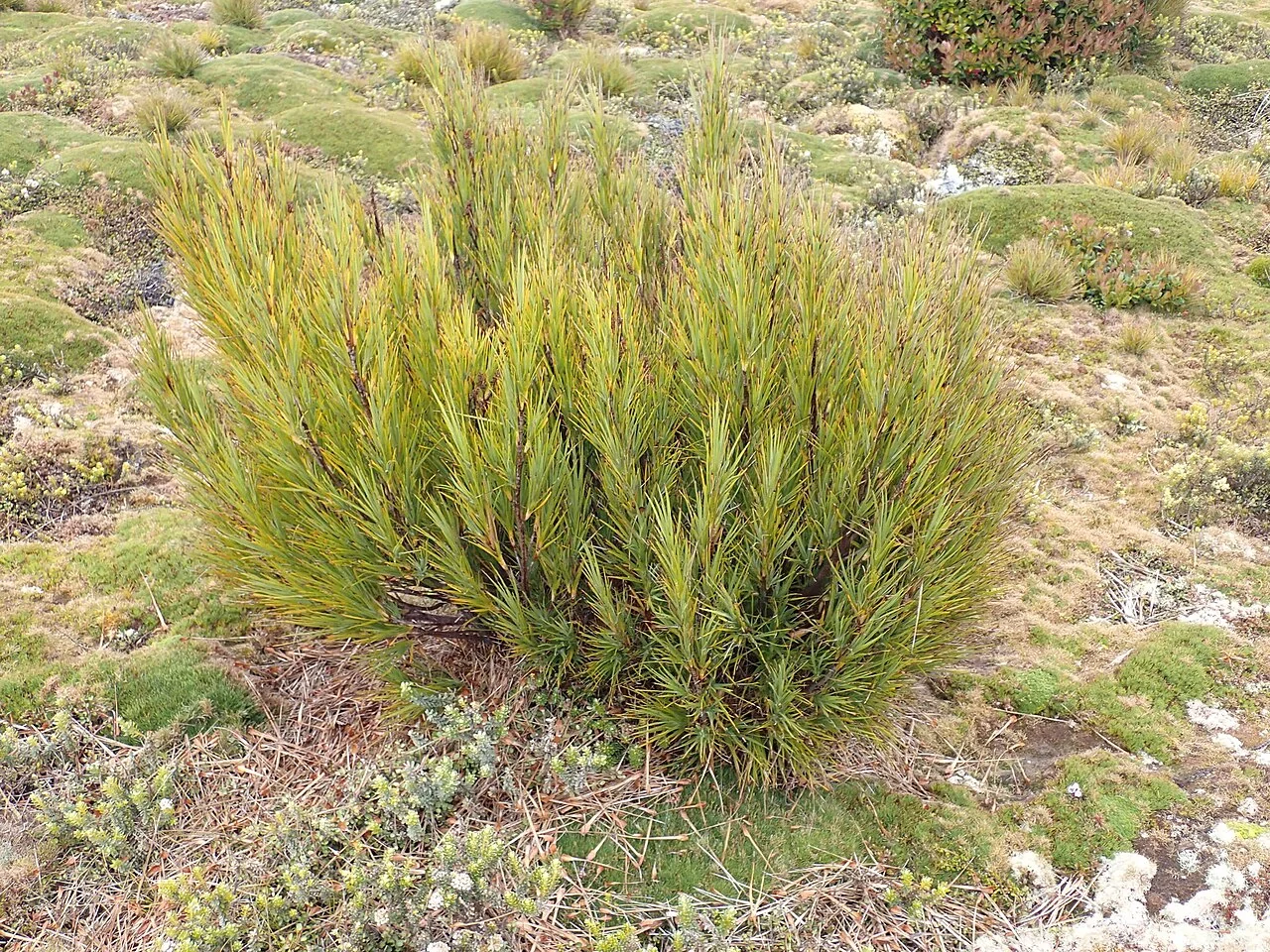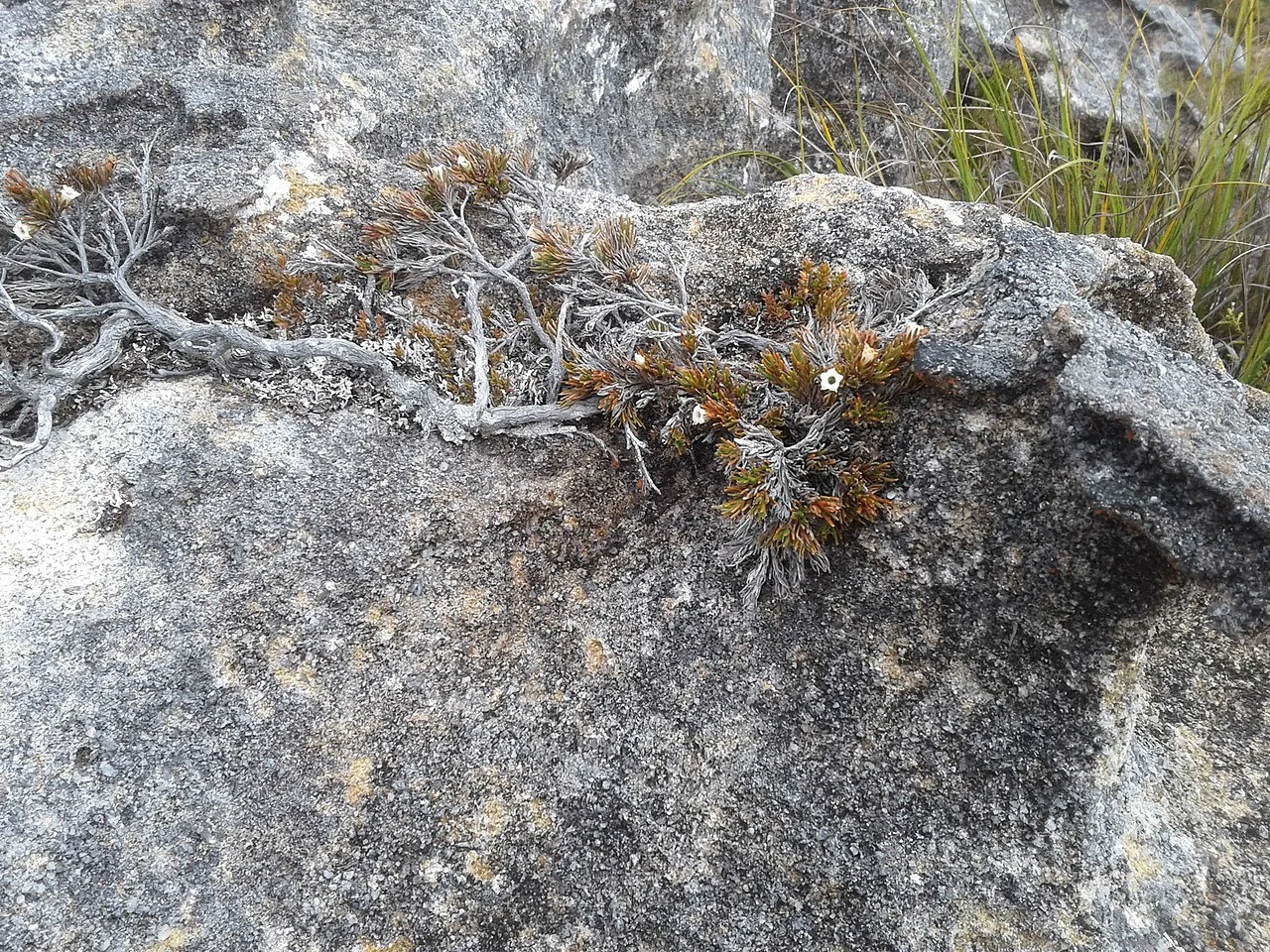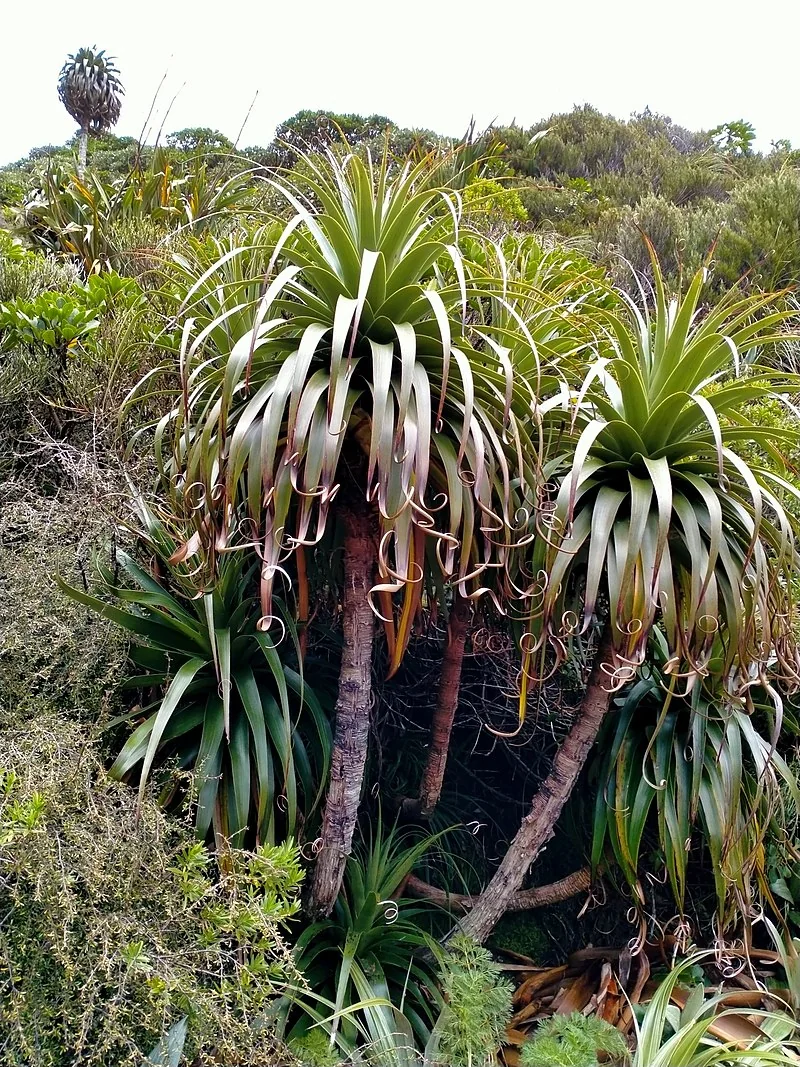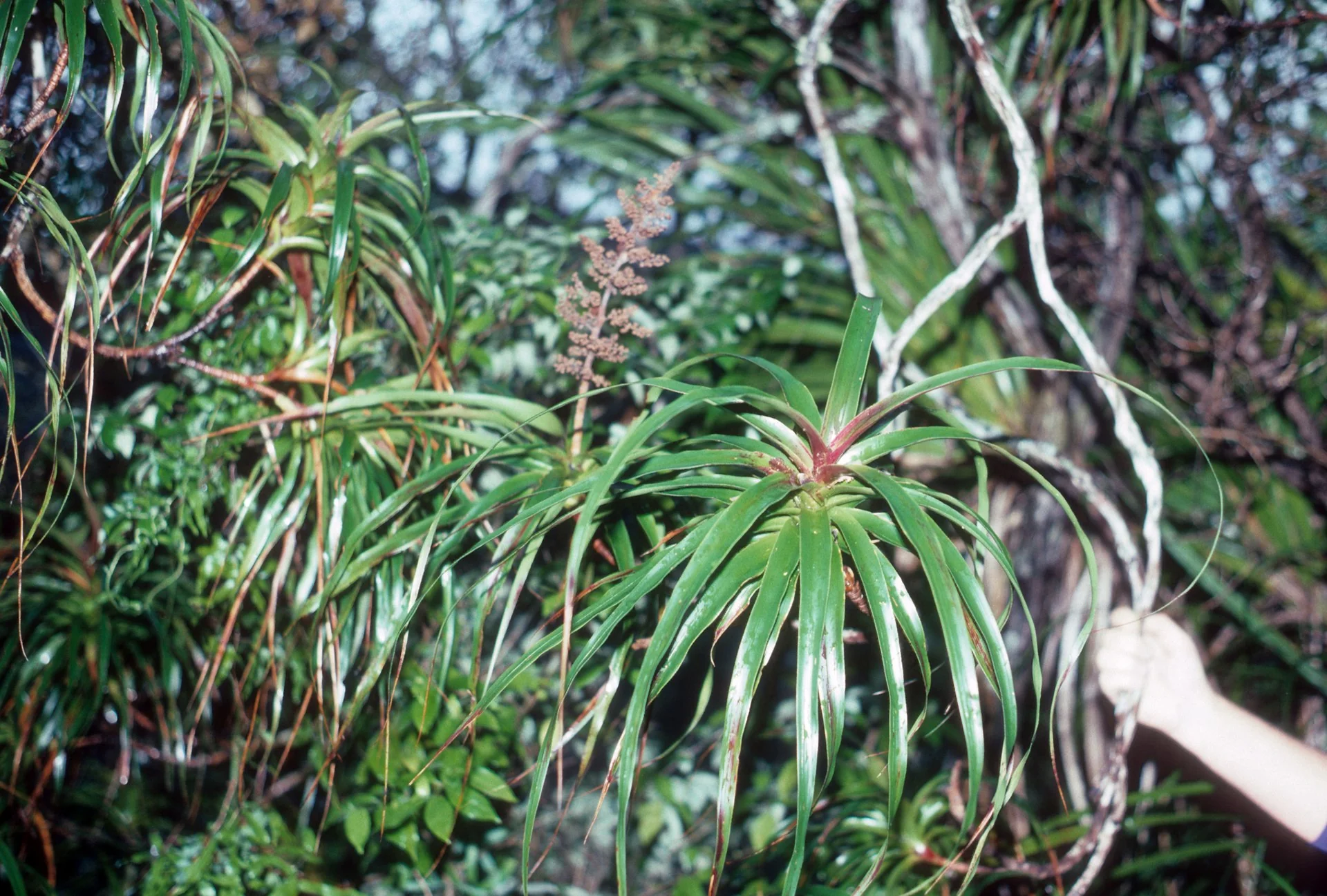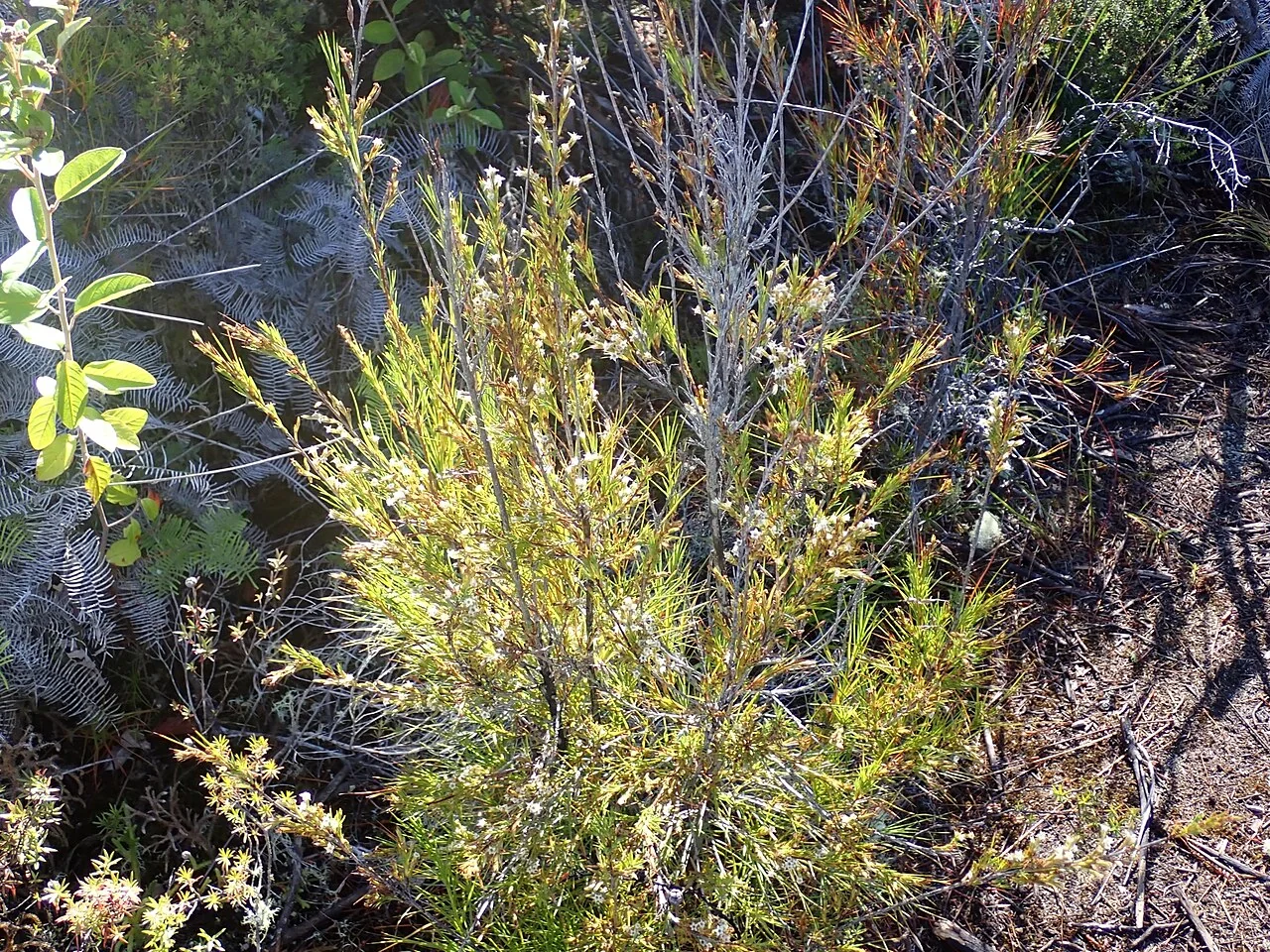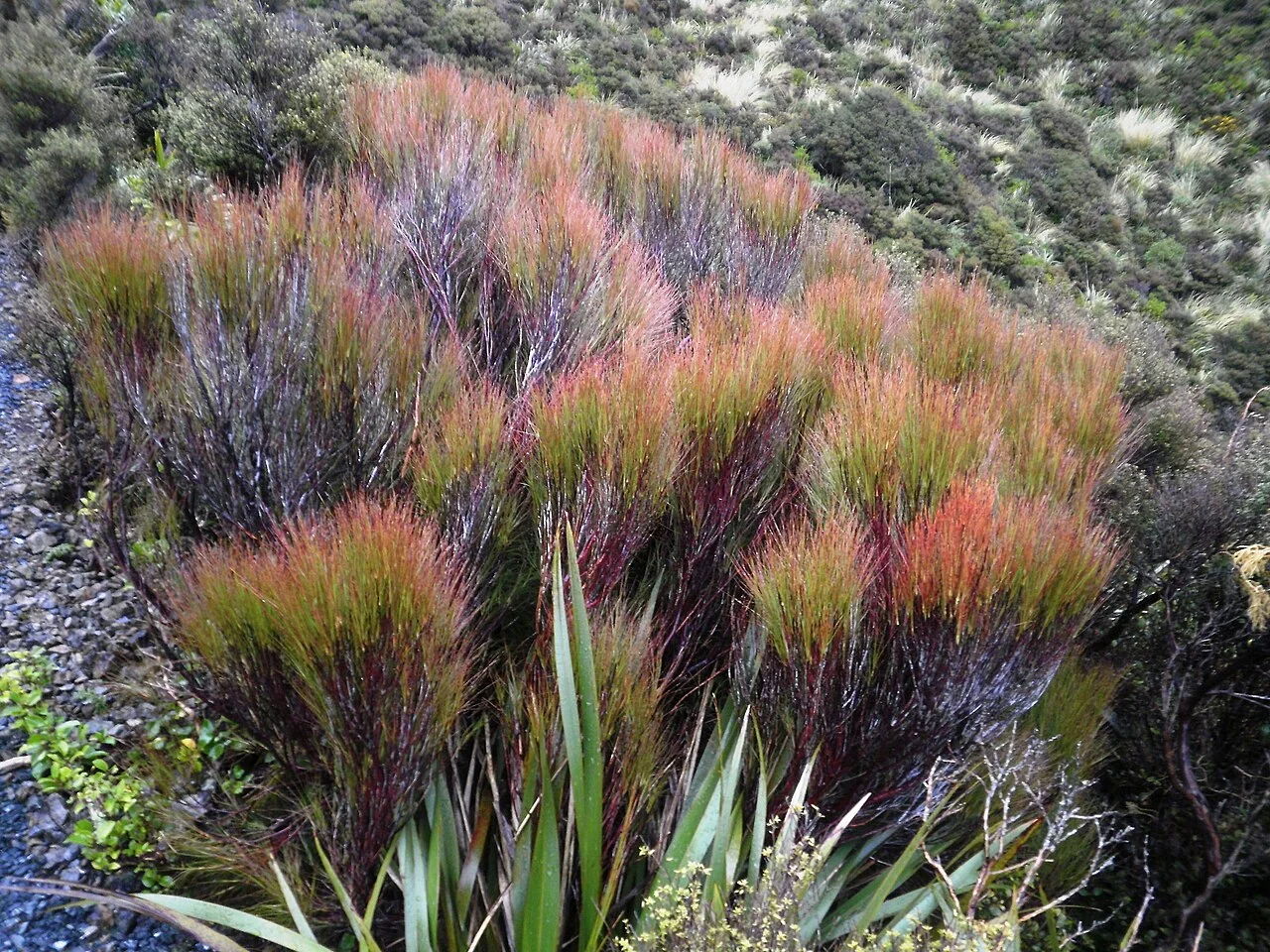
Inaka
Dracophyllum longifolium
Inaka ( Dracophyllum longifolium ) stands as New Zealand's most widely distributed and recognizable "grass tree," creating dramatic sculptural statements across the landscape with its distinctive palm-like clusters of long, narrow leaves that crown sturdy branching trunks. This remarkable native shrub represents one of the most successful examples of plant adaptation in New Zealand. This remarkable endemic shrub or small tree represents one of the most successful examples of plant adaptation in New Zealand, demonstrating extraordinary versatility by thriving in environments ranging from wind-swept coastal cliffs to alpine meadows up to 1,200 meters elevation. The plant's most striking feature lies in its distinctive growth form - dense rosettes of sword-like leaves clustered at branch tips create an almost tropical appearance that contrasts beautifully with New Zealand's temperate landscapes. These needle-like leaves, measuring up to 25cm in length and just 3-5mm wide, often display stunning colour variations from deep green through orange to rich brown, creating natural artwork that changes with seasons and growing conditions. The species demonstrates fascinating developmental plasticity, with juvenile plants producing broad, flat leaves that gradually transform into the characteristic narrow adult foliage as the plant matures - an adaptation that allows young plants to maximize photosynthesis while mature specimens reduce water loss in harsh conditions. During summer months, Inaka produces spectacular displays of fragrant white flowers arranged in panicles that emerge just below the leaf clusters, creating a striking contrast against the usually dark foliage while attracting native insects and birds. With individuals capable of living over 220 years, these plants become living monuments in the landscape, slowly developing the deeply fissured bark and multiple branching that gives mature specimens their distinctive character. Found throughout New Zealand from the subantarctic islands to the far north, but most common in the South Island, Inaka plays crucial ecological roles in stabilizing soils, providing nesting sites for native birds, and serving as a key indicator species for healthy native ecosystems.

Plant Description
Botanical Features
Dracophyllum longifolium , commonly known as Inaka or īnanga, is an upright shrub or small tree endemic to New Zealand, and is the country's most widespread "grass tree." It typically grows between 1 and 12 meters tall, with older branches having grey to blackish-brown bark and young stems being reddish-brown. The plant exhibits dimorphic leaves: juvenile leaves are very broad, long, and flat, while adult leaves are stiff, narrow, and erect, typically 40-232 mm long by 1-6 mm wide, with a pointed tip. These leaves are often softly coloured, ranging from green to orange and brown. It produces fragrant white flowers arranged in terminal racemes during summer, followed by small, dry, capsule-like fruits. This species is found throughout New Zealand, primarily in the South Island, from sea level up to 1,200 meters, thriving in open forests and subalpine scrub. Inaka is a long-lived plant, capable of surviving for up to 220 years.
Quick Facts
| Scientific Name | Dracophyllum Longifolium |
|---|---|
| Height | 2-6 m |
| Spread | 1-3 m |
| Water Needs | Low to moderate |
| Light | Full sun to part shade |
| Frost Tolerance | Good |
| Salt Tolerance | Moderate |
| Growth Rate | Slow to moderate |
| Lifespan | Long |
Climate Best Suited to
Inaka ( Dracophyllum longifolium ) thrives in well-drained, exposed conditions from coastal to montane areas. It adapts well to typical New Zealand growing conditions with appropriate care and positioning.
Regional Suitability
| Whangārei | Ideal |
| Auckland | Ideal |
| Hamilton | Suitable |
| Rotorua | Suitable |
| Tauranga | Ideal |
| Gisborne | Ideal |
| New Plymouth | Ideal |
| Whanganui | Ideal |
| Palmerston North | Suitable |
| Napier | Ideal |
| Wellington | Ideal |
| Nelson | Ideal |
| Christchurch | Suitable |
| Dunedin | Suitable |
| Invercargill | Suitable |
| City | Climate Suitability |
|---|
Natural Habitat
Dracophyllum longifolium , also known as īnanga or inaka, is an upright shrub or small tree endemic to New Zealand. It is widely distributed across the South Island, Stewart Island/Rakiura, Auckland Islands, and Campbell Island/Motu Ihupuku. While it has been erroneously reported in the North Island in the past, those plants are in fact D. filifolium.
This species can be found from sea level up to 1,200 meters (3,900 ft) in elevation. Its natural habitats are diverse, including open forests, woodlands, shrublands, and bogs. It commonly grows on mountain and hill slopes, coastal cliffs, and bluffs. In subalpine regions, it is often a significant component of subalpine scrub and sometimes mixed snow tussock-scrub. It is particularly common in the higher rainfall areas of the South and Stewart Islands.
Plant Conservation
The conservation status of Dracophyllum longifolium varies depending on its variety. The most common type, Dracophyllum longifolium var. longifolium, is classified as "Not Threatened" under the New Zealand Threat Classification System, a status reaffirmed in 2009, 2012, and 2018. However, Dracophyllum longifolium var. septentrionale is considered "At Risk - Naturally Uncommon," a classification it received in both 2012 and 2018.
Growing Requirements
Soil Requirements
Inaka ( Dracophyllum longifolium ) performs best in well-draining soil that retains adequate moisture. Like most New Zealand natives, it prefers soils that don't become waterlogged but maintain consistent moisture levels. Good drainage is essential for healthy root development.
- Well-draining soil essential for healthy growth
- Prefers consistent moisture without waterlogging
- Adapts to various soil types with good drainage
- Benefits from organic matter incorporation
- Mulching helps retain moisture and suppress weeds
Light Requirements
Inaka ( Dracophyllum longifolium ) performs well in full sun to partial shade conditions. Like many New Zealand natives, it adapts to various light conditions but typically shows best growth and form in positions that receive adequate sunlight throughout the day.
- Full sun to partial shade positions
- At least 4-6 hours of direct sunlight daily
- Tolerates light shade in warmer climates
- Morning sun particularly beneficial
Water Requirements
Inaka ( Dracophyllum longifolium ) requires regular watering during establishment, typically for the first 1-2 years. Once established, it becomes more drought-tolerant but benefits from consistent moisture during dry periods. Avoid overwatering which can lead to root problems.
- Regular watering during establishment phase
- Moderate drought tolerance once established
- Consistent moisture during dry periods beneficial
- Avoid waterlogged conditions
- Mulching helps conserve soil moisture
Planting Guide
Dracophyllum longifolium , also known as Inaka or Grass Tree, is an upright shrub or small tree endemic to New Zealand, valued for its sculptural form and adaptability. It can grow from sea level up to 1,200 meters, thriving in open forests and sub-alpine areas.
1. Ideal Planting Time
Spring is an active growth period and an ideal time for planting new specimens. Autumn is also suitable as growth slows and conditions become more favorable. If transplanting, late spring to early summer is best.
2. Location and Sunlight
Dracophyllum longifolium thrives in well-drained, exposed conditions, from coastal to montane areas. It prefers bright, indirect light, mimicking its natural dappled forest environment, aiming for 6-8 hours a day. Avoid harsh midday sun to prevent leaf scorch, and consider shading options during the brightest part of the day. Regularly rotate potted plants for even growth and light exposure.
3. Soil Requirements
This plant performs best in well-draining soil that retains adequate moisture, but does not become waterlogged. It adapts to various soil types with good drainage and prefers slightly acidic to neutral pH.
4. Planting Steps
When planting, dig a hole twice the width of the root ball. Gently place the Dracophyllum longifolium within, backfill with soil, and water thoroughly. Applying mulch can help retain soil moisture.
5. Watering
Dracophyllum longifolium thrives with consistent moisture without being waterlogged. Water weekly to maintain growth, adjusting for seasonal temperature changes. During hot, dry periods, especially for young plants, ensure adequate watering. Established plants show good heat tolerance with appropriate care. As an outdoor plant, it benefits from natural rainfall but needs supplemental watering during dry spells. During autumn, reduce watering frequency but maintain soil moisture, and in winter, reduce watering but ensure plants don't completely dry out.
6. Pruning
Minimal pruning is generally required to maintain its natural form and health. Most maintenance involves removing dead or damaged growth and light shaping if needed. Pruning can be done in early to late winter to remove damaged leaves, promoting new growth and improving air circulation. Always use clean, sharp tools to minimize disease risk.
7. Propagation
Dracophyllum longifolium can be propagated via cuttings from healthy sections or through seed sowing. For cuttings, allow them to callous before planting in well-draining soil. For both methods, maintaining high humidity, ensuring good light exposure without direct sun, and using well-draining, acidic soil are important for success. Keep moist and sheltered until established, then transplant with care.
8. Other Care Tips
Dracophyllum longifolium demands high humidity and indirect sunlight. Special care should be taken to avoid drastic temperature fluctuations and to protect the plant from strong winds. Regular misting can help maintain necessary humidity levels.
Ecological Role
Environmental Benefits
Dracophyllum longifolium , also known as Inaka, plays several crucial ecological roles in New Zealand ecosystems. It is found throughout New Zealand, from the subantarctic islands to the far north, and from sea level up to 1,200 meters elevation, thriving in diverse environments such as wind-swept coastal cliffs, open forests, and alpine meadows.
- Soil Stabilization: Inaka helps to stabilize soils, which is particularly important in its varied habitats, including coastal and alpine areas prone to erosion.
- Habitat and Nesting Sites: It provides nesting sites for native birds, contributing to the biodiversity of the areas where it grows.
- Indicator Species: Dracophyllum longifolium serves as a key indicator species for healthy native ecosystems, suggesting good environmental conditions where it thrives.
- Subalpine Scrub Component: In subalpine regions, it is often an important part of the subalpine scrub and sometimes mixed snow tussock-scrub communities.
- Adaptability and Resilience: This endemic shrub or small tree demonstrates extraordinary versatility, adapting to various soil types with good drainage and tolerating challenging open habitats, making it a resilient plant within its ecosystems.
Uses and Significance
Garden Uses
- Excellent for native plant gardens and restoration
- Suitable for naturalistic landscape designs
- Low maintenance once established
- Contributes to local biodiversity
- Attractive to beneficial native wildlife
Cultural Significance
Traditional Uses and Values
Dracophyllum longifolium , commonly known by its Māori name inaka (or īnanga in the North Island dialect), holds cultural significance primarily within New Zealand's native ecosystems and through its distinctive appearance.
- Māori Recognition: The plant is well-recognized by Māori, who gave it the name inaka, acknowledging its presence and role in the natural landscape.
- Distinctive Appearance: Its unique palm-like growth and sculptural form, characterized by dense rosettes of sword-like leaves, make it a notable feature of the New Zealand environment.
- Ecological Importance: Dracophyllum longifolium contributes significantly to healthy native ecosystems by stabilizing soils and providing nesting sites for native birds.
- Adaptability and Longevity: Its remarkable adaptability allows it to thrive in diverse environments, from coastal cliffs to alpine regions, and its ability to live for over 220 years makes older specimens "living monuments" in the landscape.
Landscaping Uses
Dracophyllum longifolium , also known as inaka, is a versatile New Zealand native plant highly valued for its landscaping uses, particularly in native gardens and restoration projects. It is recognized for its distinctive palm-like appearance, which creates dramatic sculptural statements in the landscape.
Key Landscaping Applications:
- Aesthetic Appeal: Its unique form, with clusters of long, narrow leaves that can vary in colour from deep green to orange and brown, provides significant aesthetic value. It can be used to create naturalistic landscape designs.
- Ecological Benefits: Dracophyllum longifolium contributes to local biodiversity, provides nesting sites for native birds, and attracts beneficial native wildlife. It also plays crucial ecological roles in stabilizing soils.
- Versatility: It is suitable for various landscape applications and can even be a dominant element in certain habitats.
- Low Maintenance: Once established, it requires minimal maintenance.
Seasonal Care Calendar
Spring
Spring is an active growth period for Inaka ( Dracophyllum longifolium ). New growth emerges and this is an ideal time for planting new specimens. Monitor soil moisture as temperatures warm and growth accelerates.
- Active growth period with new foliage development
- Ideal time for planting new specimens
- Monitor soil moisture as temperatures rise
- Apply organic mulch if needed
Summer
Summer is typically the main growing season for Inaka ( Dracophyllum longifolium ). Ensure adequate watering during hot, dry periods, especially for young plants. Established plants show good heat tolerance with appropriate care.
- Peak growing season with active development
- Monitor watering needs during hot weather
- Young plants need consistent moisture
- Established plants show good heat tolerance
Autumn
During autumn, Inaka ( Dracophyllum longifolium ) begins to slow its growth as temperatures cool. This is another good time for planting as conditions become more favorable. Reduce watering frequency but maintain soil moisture.
- Growth slows as temperatures moderate
- Good time for planting new specimens
- Reduce watering frequency gradually
- Maintain soil moisture without overwatering
Winter
Winter is typically a dormant period for Inaka ( Dracophyllum longifolium ), with minimal growth activity. Reduce watering but ensure plants don't completely dry out. Most New Zealand natives are cold-hardy and require minimal winter protection.
- Dormant period with minimal growth activity
- Reduce watering but avoid complete drying
- Generally cold-hardy in most New Zealand climates
- Minimal winter protection required
When to Prune and How Much
Inaka ( Dracophyllum longifolium ) generally requires minimal pruning to maintain its natural form and health. Most maintenance involves removing dead or damaged growth and light shaping if needed.
- Remove dead, damaged, or diseased growth as needed
- Light pruning to maintain shape if desired
- Prune after flowering if applicable
- Avoid heavy pruning which can stress the plant
- Use clean, sharp tools to prevent disease
- Most natives maintain good form without regular pruning
Always use clean, sharp tools when pruning to minimize disease risk. Native plants typically maintain their natural form well and often require less intervention than exotic species.
How to Grow Inaka
Inaka, also known as the Grass Tree, is a distinctive and hardy native shrub or small tree that adds a unique architectural element to any garden. Its long, narrow, grass-like leaves clustered at the branch tips create a striking, almost tropical appearance, while its adaptability to a wide range of conditions, from coastal cliffs to alpine meadows, makes it a versatile choice for native plantings. While it is a slow-growing species, its resilience and unique aesthetic make it a rewarding plant to cultivate. Understanding its propagation methods is key to successfully growing this specialized species.
From Seed
Propagating Inaka from seed can be a slow process, but it is often the most reliable method for this species. Collect fresh seeds when ripe, typically in late summer or autumn. Sow the seeds onto a well-draining seed-raising mix, lightly covering them with a thin layer of fine grit or sand. The seeds may benefit from a period of cold stratification (placing seeds in a moist medium in the refrigerator for 4-6 weeks) to improve germination rates. Maintain consistent moisture in the seed tray and provide cool, bright conditions. Germination can be erratic and may take several months. Once seedlings have developed a few true leaves, they can be potted into individual containers and grown in a sheltered location before planting out.
From Cuttings
Inaka can also be propagated from semi-hardwood cuttings, typically taken in late summer or early autumn from healthy, current season's growth. Cuttings should be about 4-6 inches long. Remove the lower leaves and dip the cut end in a rooting hormone. Plant the cuttings into a well-draining, sterile cutting mix, such as a blend of perlite and sand. Maintain high humidity around the cuttings, perhaps by placing them under a plastic dome or in a propagator, and provide bottom heat to encourage root development. Keep the medium consistently moist but not waterlogged. Rooting can be slow and success rates can vary, making this method more suitable for experienced propagators.
Pests and Diseases
Dracophyllum longifolium , also known as Inaka, is a hardy native New Zealand shrub or small tree that generally requires minimal maintenance and is not extensively documented for specific pests or diseases.
General Health and Prevention:
- Disease Prevention through Pruning: Using clean, sharp tools when pruning helps to minimize the risk of disease.
- Optimal Growing Conditions: Dracophyllum longifolium thrives in well-drained soil and prefers consistent moisture without becoming waterlogged. Providing these conditions can help prevent issues that arise from environmental stress.
In summary, Dracophyllum longifolium is considered a resilient plant, and maintaining good horticultural practices is the primary recommendation for keeping it healthy.
Bonus Tip
Expert Growing Advice
Dracophyllum longifolium , or Inaka, is a plant of many surprises! While it can grow into a small tree up to 12 meters tall in open forests, in harsh sub-alpine areas, it often remains a compact shrub of just 1 to 1.5 meters. This remarkable adaptability allows it to thrive in diverse environments, from coastal cliffs to alpine meadows. Even more fascinating is its lifespan; some individuals can live for over 220 years, making them true living monuments in the landscape. Its juvenile leaves are broad and flat, gradually transforming into the characteristic narrow adult foliage as the plant matures, a clever adaptation to reduce water loss in challenging conditions.
